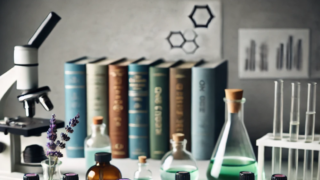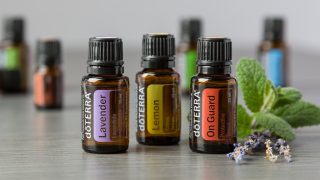Aromaterapia a chûˋmia esenciûÀlnych olejov
Silnû§ potenciûÀl aromatickû§ch molekû¤l na vaéÀe zdravie
| The eugenol molecule found in clove oil. |
Uéƒ ste si niekedy doniesli domov olej z obchodu zo zdravû§m jedlom a nedéÀene ste oáakûÀvali û¤éƒasnû¤ lieáebnû¤ skû¤senoséË, iba , eagerly anticipating a wonderful, healing experience, only to be disappointed?ô Like, „What’s going on here?ô I thought aromatherapy was supposed to be God’s gift to mankind, or something.“
If that’s your experience, you’re by no means alone.ô But there’s a reason for this:
- Effective aromatherapy begins with truly great oils.ô If your oils are not CPTGôÛ, certified-pure-therapeutic-grade(and if you got them at a health food store, I can pretty much guarantee you that they aren’t), you simply won’t see the results you’re hoping for.
And, while a CPTGôÛ, certified-pure-therapeutic-grade essential oil will be noted for its fragrance and frequency, it’s the powerful potential of the oil’s aromatic molecules ã its chemistry ã that sets aromatherapy apart as a truly superior health-promoting practice.
Essential oil chemistry: A delicate mosaic of aromatic molecules
Essential oils are far from simple substances.ô In fact, few people appreciate how chemically complex essential oils really are.
Every essential oil contains an amazing array ã a delicate mosaic ãof aromatic molecules.ô They give the oil its powerful potential for healing.ô They are also what gives it its distinctive fragrance.ô And, while fragrance itself can have profound effects upon our emotions, these aromatic molecules, because of their chemical make-up, have many other effects, as well.
Essential oil chemistry and its therapeutic effects
As of 1995, chemists have identified more than 3,000 aromatic molecules.ô Each of these has specific therapeutic activities upon the body.ô However, the practice of aromatherapy isn’t as simple as applying an oil that contains a specific chemical constituent, in order to achieve a particular therapeutic effect.
Why?
Because the complexity of an essential oil, with the interplay of its many constituents, means that there is no straight line between the activity of one of its components and the effects of the complete oil.
Even a fairly simple essential oil may contain anywhere from 80 to 300 different chemical constituents.ô An essential oil like lavender is far more complex.ô Many of an oil’s constituents occur in very minute quantities; but all contribute important qualities to the oil, having a synergistic impact on its therapeutic effects.ô (See the article, „The Scent of Grapefruit“ for an example of this.)
Many of these chemical compounds have been identified, and new ones are being discovered; but many remain unknown, and the relationships between them are not well understood.ô However, these molecules can be grouped together into families, each with its own therapeutic properties.ô Representative of this is the following chart.
| Káƒû¤áovûˋ chemickûˋ zloéƒky esenciûÀlnych olejov a ich û¤áinky | ||
| Zloéƒka | Olej, ktorû§ ju obsahuje | ûáinok |
| Ketones | RozmarûÙn | Mucolytickû§ |
| Aldehydes | Lemongrass | Calming (upokojujû¤ci) |
| Esters | Levandula | Balancing |
| Alcohols | Geranium | Toning (tonizujû¤ci) |
| Phenols | Oregano | Stimulant |
| Terpenes | White Fir | Stimulant |
Different therapeutic actions of chemical constituents
Chemically, essential oils are very heterogeneous, giving the same oil many diverse effects within the body.ô A single essential oil can play many different therapeutic roles.ô This is very different than the effects of synthetic chemicals, which have only a single action.
The therapeutic action of essential oils preserves the body’s natural balance
Because of their chemical complexity, essential oils don’t disturb the body’s natural balance ã or homeostasis.ô If one constituent exerts too strong an effect in one direction, another constituent may block or counteract it.
For example: certain aromatic molecules in an oil may be very stimulating ã both psychologically and physically.ô But, the same essential oil may also contain constituents that are calming and sedating, helping to overcome anxiety or hyperactivity.
And, because the oils are natural substances, they tend to go only where they’re needed, and provide only the action needed to help restore the body’s natural balance.ô The same oil may have significantly different effects on a person from one application to the next, depending on his/her need at that moment.ô This quality of essential oils makes aromatherapy very safe and, incidentally, makes choosing the right oil less problematic.
This is in stark contrast to synthetic chemicals, which often interrupt the body’s homeostasis, forcing an action based upon the chemical’s make-up, not on what the body needs.
Another interesting point: While it’s possible to duplicate these chemical constituents in the laboratory and blend them together into a concoction that smells like an essential oil, scientists have yet to duplicate the therapeutic effects of a truly CPTGôÛ, certified-pure-therapeutic-grade essential oil.
Essential oil chemistry and drug-resistant pathogens
The research of scientists like Dr. Jean C. Lapraz, Dr. Daniel Pûˋnoû¨l, M.D. and Pierre Franchomme has documented that the complex chemistry of essential oils takes on even greater significance as we’re faced with the life-threatening, drug-resistant viruses and bacteria coming on the scene year-by-year.ô The chemical complexity of an essential oil, and the fact that each batch of a truly CPTGôÛ, certified-pure-therapeutic-grade essential oil will vary somewhat from another, makes if difficult for microorganisms to mutate into a form that is resistant to essential oils.
In 1985, Dr. Jean C. Lapraz said that he couldn’t find any microbe that could live in the presence of the essential oils of cinnamon or oregano.ô It’s also well documented that phenols found in oregano and thyme are highly anti-microbial.








